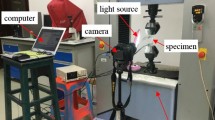Abstract
The aluminum-lithium alloy 2060-T8 is widely utilized in the fabrication of future aircrafts. With the application of this high-strength alloy, the severe shape variation after unloading has been challenging the traditional process for forming fuselage skin components. In this study, the three-roller bending process with the 2060-T8 alloy for fuselage skins was investigated with theoretical calculations, finite simulations and experiments. Uniaxial tensile tests of 2060-T8 alloy were carried out and three-roller cylindrical bending experiments were accomplished. The prediction with analytic models was conducted to determine the upper roller feeding and residual stress with the desired radius. To promote the predicting accuracy, an adaptive fitting method was adopted to determine the elastic-exponential hardening model variably. The same forming processes were also simulated with Abaqus software for comparison. Finally, the configuration and residual stress of the experimental plates were measured. The forming curves predicted with different approaches were presented in the comparison with measurements. The good agreement of the theoretical estimations verified the analytic models with variable material model. The crucial reason caused the decrease of predicting accuracy in theoretical calculation was revealed in the analysis and verifications.











Similar content being viewed by others
References
Rioja RJ, Liu J (2012) The evolution of Al-Li base products for aerospace and apace applications. Metall Mater Trans A 43(9):3325–3337. doi:10.1007/s11661-012-1155-z
Prasad NE, Gokhale A, Wanhill RJH (2013) Aluminum-lithium alloys: processing, properties, and applications. Butterworth-heinemann, Oxford
Bodily B, Heinimann M, Bray G, Colvin E, Witters J (2012) Advanced aluminum and aluminum-lithium solutions for derivative and next generation aerospace structures. SAE technical paper 2012–01–1874. doi:10.4271/2012-01-1874
Dursun T, Soutis C (2014) Recent developments in advanced aircraft aluminium alloys. Mater Des 56:862–871. doi:10.1016/j.matdes.2013.12.002
Li J, Wang S (2016) Distortion caused by residual stresses in machining aeronautical aluminum alloy parts: recent advances. Int J Adv Manuf Technol 1–16. doi:10.1007/s00170-016-9066-6
Leacock AG, McCracken D, Brown D, McMurray R (2012) Numerical simulation of the four roll bending process. Mater Manuf Process 27(4):370–376. doi:10.1080/10426914.2011.560228
Tvergaard V, Needleman A (1975) On the buckling of elastic-plastic columns with asymmetric cross-sections. Int J Mech Sci 17(6):419–424. doi:10.1016/0020-7403(75)90039-9
Hansen N, Jannerup O (1979) Modelling of elastic-plastic bending of beams using a roller bending machine. J Manuf Sci Eng 101(3):304–310
Hardt D, Constantine E, Wright A (1992) A model of the sequential bending process for manufacturing simulation. J Manuf Sci Eng 114(2):181–187
Xu F (1991) Calculation of the exerting force necessary to form the aircraft hull plate in the symmetry plate bender with three rolls and the feeding value of the centre roll. Acta Aeronautica Et Astronautica Sinica 12(7):A401–A410
Mao YS, Hou L, Wang CF (2003) Calculation and auto-control model of plate roll-bending forming. Shipbuilding of China 44(161):74–80
Gandhi A, Raval H (2008) Analytical and empirical modeling of top roller position for three-roller cylindrical bending of plates and its experimental verification. J Mater Process Technol 197(1):268–278
Tran QH, Champliaud H, Feng Z, Dao TM (2014) Analysis of the asymmetrical roll bending process through dynamic FE simulations and experimental study. Int J Adv Manuf Technol 75(5):1233–1244. doi:10.1007/s00170-014-6176-x
Tran HQ (2014) Asymmetrical roll bending process study: dynamic finite element modeling and experiments. Université du Québec: École de technologie supérieure, Québec
Chudasama MK, Raval HK (2013) An approximate bending force prediction for 3-roller conical bending process. Int J Mater Form 6(2):303–314. doi:10.1007/s12289-011-1087-y
Shim D, Son J, Lee E, Baek G (2016) Improvement strategy for edge waviness in roll bending process of corrugated sheet metals. Int J Mater Form 1–16. doi:10.1007/s12289-016-1303-x
Cai Z, Li M, Lan Y (2012) Three-dimensional sheet metal continuous forming process based on flexible roll bending: principle and experiments. J Mater Process Technol 212(1):120–127. doi:10.1016/j.jmatprotec.2011.08.014
Coleman TF, Li Y (1994) On the convergence of reflective newton methods for large-scale nonlinear minimization subject to bounds. Math Program 67(2):189–224
Coleman TF, Li Y (1996) An interior, trust region approach for nonlinear minimization subject to bounds. SIAM J Optim 6:418–445
Cai Z, Diao K, Wu X, Wan M (2016) Constitutive modeling of evolving plasticity in high strength steel sheets. Int J Mech Sci 107:43–57. doi:10.1016/j.ijmecsci.2016.01.006
Barlat F, Brem JC, Yoon JW, Chung K, Dick RE, Lege DJ, Pourboghrat F, Choi SH, Chu E (2003) Plane stress yield function for aluminum alloy sheets—part 1: theory. Int J Plast 19(9):1297–1319. doi:10.1016/S0749-6419(02)00019-0
Ktari A, Antar Z, Haddar N, Elleuch K (2012) Modeling and computation of the three-roller bending process of steel sheets. J Mech Sci Technol 26(1):123–128. doi:10.1007/s12206-011-0936-4
Schuster S, Gibmeier J (2016) Incremental hole drilling for residual stress analysis of strongly textured material states – a new calibration approach. Exp Mech 56(3):369–380. doi:10.1007/s11340-015-0104-3
Li J, Wang H, Sun G, Chen B, Chen Y, Pang B, Zhang Y, Wang Y, Zhang C, Gong J, Liu Y (2015) Neutron diffractometer RSND for residual stress analysis at CAEP. Nuclear Instruments and Methods in Physics Research Section A: Accelerators, Spectrometers, Detectors and Associated Equipment 783:76–79. doi:10.1016/j.nima.2015.02.026
Acknowledgements
The HONGDU Aviation Industry (Group) Corporation Limited provided the material and the roller-bending machine for this study. The authors would like to acknowledge the funding support to this research from the program of “Technology Research on Roller Bending of Al-Li Alloy for Skins on Commercial Aircraft C919”.
Author information
Authors and Affiliations
Corresponding author
Ethics declarations
Conflict of interest
The authors declare that they have no conflict of interest.
Rights and permissions
About this article
Cite this article
Peng, J., Li, W., Wan, M. et al. Investigation on three-roller cylindrical bending of 2060-T8 Al-Li alloy plate for aircraft fuselage skin components. Int J Mater Form 11, 269–278 (2018). https://doi.org/10.1007/s12289-017-1350-y
Received:
Accepted:
Published:
Issue Date:
DOI: https://doi.org/10.1007/s12289-017-1350-y



